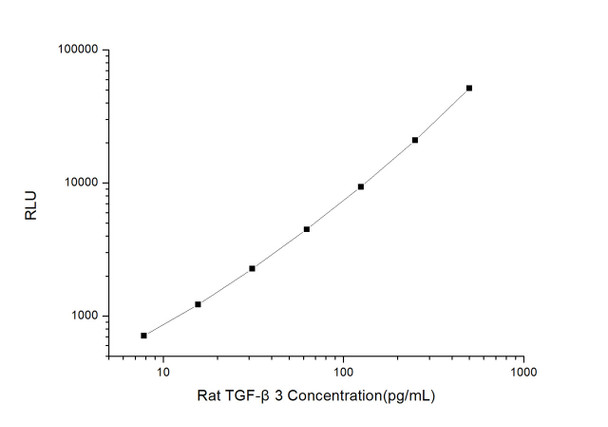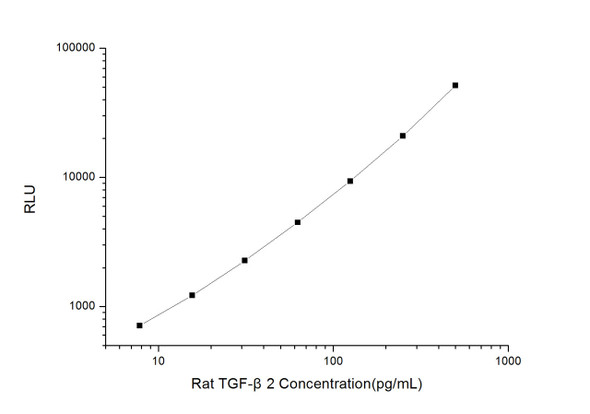Rat Signaling ELISA Kits 3
Rat TGF- beta3 (Transforming Growth Factor Beta 3) CLIA Kit (RTES00569)
- SKU:
- RTES00569
- Product Type:
- ELISA Kit
- ELISA Type:
- CLIA Kit
- Size:
- 96 Assays
- Sensitivity:
- 4.69pg/mL
- Range:
- 7.81-500pg/mL
- ELISA Type:
- Sandwich
- Reactivity:
- Rat
- Sample Type:
- Serum, plasma and other biological fluids
Description
| Assay type: | Sandwich |
| Format: | 96T |
| Assay time: | 4.5h |
| Reactivity: | Rat |
| Detection method: | Chemiluminescence |
| Detection range: | 7.81-500 pg/mL |
| Sensitivity: | 4.69 pg/mL |
| Sample volume: | 100µL |
| Sample type: | Serum, plasma and other biological fluids |
| Repeatability: | CV < 15% |
| Specificity: | This kit recognizes Rat TGF- beta3 in samples. No significant cross-reactivity or interference between Rat TGF- beta3 and analogues was observed. |
This CLIA kit uses Sandwich-CLIA as the method. The micro CLIA plate provided in this kit has been pre-coated with an antibody specific to Rat TGF- beta3. Standards or samples are added to the micro CLIA plate wells and combined with the specific antibody. Then a biotinylated detection antibody specific for Rat TGF- beta3 and Avidin-Horseradish Peroxidase (HRP) conjugate are added to each micro plate well successively and incubated. Free components are washed away. The substrate solution is added to each well. Only those wells that contain Rat TGF- beta3, biotinylated detection antibody and Avidin-HRP conjugate will appear fluorescence. The Relative light unit(RLU) value is measured spectrophotometrically by the Chemiluminescence immunoassay analyzer. The RLU value is positively associated with the concentration of Rat TGF- beta3. You can calculate the concentration of Rat TGF- beta3 in the samples by comparing the RLU value of the samples to the standard curve.
| UniProt Protein Function: | TGFB3: Involved in embryogenesis and cell differentiation |
| UniProt Protein Details: | Protein type:Cell development/differentiation; Ligand, receptor tyrosine kinase; Motility/polarity/chemotaxis; Secreted; Secreted, signal peptide Cellular Component: cell soma; cell surface; cytoplasm; extracellular matrix; extracellular space; nucleus; proteinaceous extracellular matrix; secretory granule; T-tubule Molecular Function:cytokine activity; identical protein binding; protein heterodimerization activity; punt binding; transforming growth factor beta binding; transforming growth factor beta receptor binding Biological Process: activation of MAPK activity; aging; alveolus development; cell development; embryonic neurocranium morphogenesis; female pregnancy; gut development; in utero embryonic development; inner ear development; intercellular junction assembly and maintenance; mammary gland development; negative regulation of cell proliferation; negative regulation of DNA replication; negative regulation of neuron apoptosis; negative regulation of transforming growth factor beta receptor signaling pathway; organ morphogenesis; palate development; positive regulation of apoptosis; positive regulation of bone mineralization; positive regulation of collagen biosynthetic process; positive regulation of DNA replication; positive regulation of filopodium formation; positive regulation of protein secretion; positive regulation of transcription from RNA polymerase II promoter; positive regulation of transcription, DNA-dependent; regulation of endothelial cell differentiation; regulation of epithelial cell differentiation; regulation of epithelial cell proliferation; response to estrogen stimulus; response to hypoxia; response to progesterone stimulus; salivary gland morphogenesis; SMAD protein nuclear translocation; transforming growth factor beta receptor signaling pathway; wound healing |
| NCBI Summary: | involved in epithelial and endothelial cell proliferation and differentiation during development [RGD, Feb 2006] |
| UniProt Code: | Q07258 |
| NCBI GenInfo Identifier: | 1351228 |
| NCBI Gene ID: | 25717 |
| NCBI Accession: | Q07258. 2 |
| UniProt Secondary Accession: | Q07258,Q56A31, |
| UniProt Related Accession: | Q07258 |
| Molecular Weight: | 47,116 Da |
| NCBI Full Name: | Transforming growth factor beta-3 |
| NCBI Synonym Full Names: | transforming growth factor, beta 3 |
| NCBI Official Symbol: | Tgfb3 |
| NCBI Official Synonym Symbols: | TGF-B3 |
| NCBI Protein Information: | transforming growth factor beta-3; TGF-beta-3 |
| UniProt Protein Name: | Transforming growth factor beta-3 |
| Protein Family: | Transforming growth factor |
| UniProt Gene Name: | Tgfb3 |
| UniProt Entry Name: | TGFB3_RAT |
As the RLU values of the standard curve may vary according to the conditions of the actual assay performance (e. g. operator, pipetting technique, washing technique or temperature effects), the operator should establish a standard curve for each test. Typical standard curve and data is provided below for reference only.
| Concentration (pg/mL) | RLU | Average | Corrected |
| 500 | 46842 56232 | 51537 | 51508 |
| 250 | 19261 22735 | 20998 | 20969 |
| 125 | 9796 8996 | 9396 | 9367 |
| 62.5 | 4264 4760 | 4512 | 4483 |
| 31.25 | 2335 2263 | 2299 | 2270 |
| 15.63 | 1311 1189 | 1250 | 1221 |
| 7.81 | 731 749 | 740 | 711 |
| 0 | 29 29 | 29 | -- |
Precision
Intra-assay Precision (Precision within an assay): 3 samples with low, mid range and high level Rat TGF- beta3 were tested 20 times on one plate, respectively.
Inter-assay Precision (Precision between assays): 3 samples with low, mid range and high level Rat TGF- beta3 were tested on 3 different plates, 20 replicates in each plate.
| Intra-assay Precision | Inter-assay Precision | |||||
| Sample | 1 | 2 | 3 | 1 | 2 | 3 |
| n | 20 | 20 | 20 | 20 | 20 | 20 |
| Mean (pg/mL) | 27.47 | 67.02 | 189.29 | 28.93 | 63.82 | 170.93 |
| Standard deviation | 2.95 | 6.23 | 21.24 | 3.45 | 6.26 | 10.63 |
| C V (%) | 10.74 | 9.30 | 11.22 | 11.93 | 9.81 | 6.22 |
Recovery
The recovery of Rat TGF- beta3 spiked at three different levels in samples throughout the range of the assay was evaluated in various matrices.
| Sample Type | Range (%) | Average Recovery (%) |
| Serum (n=5) | 96-111 | 104 |
| EDTA plasma (n=5) | 98-113 | 106 |
| Cell culture media (n=5) | 89-103 | 95 |
Linearity
Samples were spiked with high concentrations of Rat TGF- beta3 and diluted with Reference Standard & Sample Diluent to produce samples with values within the range of the assay.
| Serum (n=5) | EDTA plasma (n=5) | Cell culture media (n=5) | ||
| 1:2 | Range (%) | 102-118 | 103-115 | 86-100 |
| Average (%) | 108 | 109 | 92 | |
| 1:4 | Range (%) | 88-99 | 100-116 | 96-109 |
| Average (%) | 93 | 107 | 103 | |
| 1:8 | Range (%) | 88-99 | 86-99 | 97-108 |
| Average (%) | 94 | 93 | 102 | |
| 1:16 | Range (%) | 86-98 | 102-120 | 88-103 |
| Average (%) | 92 | 110 | 94 |
An unopened kit can be stored at 4°C for 1 month. If the kit is not used within 1 month, store the items separately according to the following conditions once the kit is received.
| Item | Specifications | Storage |
| Micro CLIA Plate(Dismountable) | 8 wells ×12 strips | -20°C, 6 months |
| Reference Standard | 2 vials | |
| Concentrated Biotinylated Detection Ab (100×) | 1 vial, 120 µL | |
| Concentrated HRP Conjugate (100×) | 1 vial, 120 µL | -20°C(shading light), 6 months |
| Reference Standard & Sample Diluent | 1 vial, 20 mL | 4°C, 6 months |
| Biotinylated Detection Ab Diluent | 1 vial, 14 mL | |
| HRP Conjugate Diluent | 1 vial, 14 mL | |
| Concentrated Wash Buffer (25×) | 1 vial, 30 mL | |
| Substrate Reagent A | 1 vial, 5 mL | 4°C (shading light) |
| Substrate Reagent B | 1 vial, 5 mL | 4°C (shading light) |
| Plate Sealer | 5 pieces | |
| Product Description | 1 copy | |
| Certificate of Analysis | 1 copy |
- Set standard, test sample and control (zero) wells on the pre-coated plate and record theirpositions. It is recommended to measure each standard and sample in duplicate. Note: addall solutions to the bottom of the plate wells while avoiding contact with the well walls. Ensuresolutions do not foam when adding to the wells.
- Aliquot 100õl of standard solutions into the standard wells.
- Add 100õl of Sample / Standard dilution buffer into the control (zero) well.
- Add 100õl of properly diluted sample (serum, plasma, tissue homogenates and otherbiological fluids. ) into test sample wells.
- Cover the plate with the sealer provided in the kit and incubate for 90 min at 37ðC.
- Aspirate the liquid from each well, do not wash. Immediately add 100õL of BiotinylatedDetection Ab working solution to each well. Cover the plate with a plate seal and gently mix. Incubate for 1 hour at 37ðC.
- Aspirate or decant the solution from the plate and add 350õL of wash buffer to each welland incubate for 1-2 minutes at room temperature. Aspirate the solution from each well andclap the plate on absorbent filter paper to dry. Repeat this process 3 times. Note: a microplatewasher can be used in this step and other wash steps.
- Add 100õL of HRP Conjugate working solution to each well. Cover with a plate seal andincubate for 30 min at 37ðC.
- Aspirate or decant the solution from each well. Repeat the wash process for five times asconducted in step 7.
- Add 100õL of Substrate mixture solution to each well. Cover with a new plate seal andincubate for no more than 5 min at 37ðC. Protect the plate from light.
- Determine the RLU value of each well immediately.






